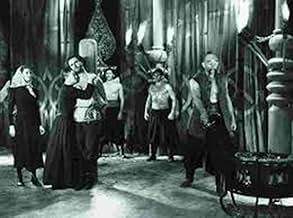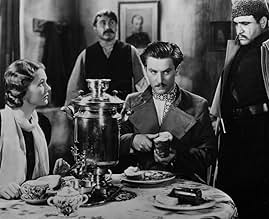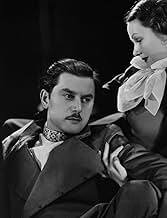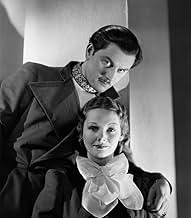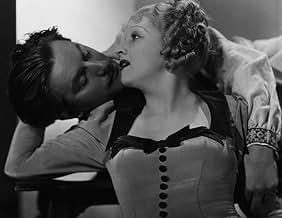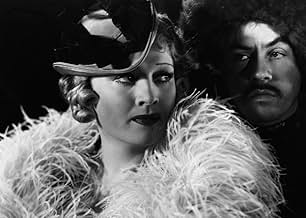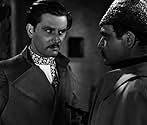Füge eine Handlung in deiner Sprache hinzuA Russian courier struggles to deliver a message to the troops fighting Tartar invaders.A Russian courier struggles to deliver a message to the troops fighting Tartar invaders.A Russian courier struggles to deliver a message to the troops fighting Tartar invaders.
- Auszeichnungen
- 1 wins total
Oscar Apfel
- Tsar's General
- (Nicht genannt)
Margaret Armstrong
- Gypsy Woman
- (Nicht genannt)
Matthew Betz
- Chieftain
- (Nicht genannt)
Ward Bond
- Tartar Guard
- (Nicht genannt)
Lynton Brent
- Sailor
- (Nicht genannt)
Leonard Ceeley
- Tsar's Aide
- (Nicht genannt)
Harry Cording
- Peasant
- (Nicht genannt)
Empfohlene Bewertungen
THE ADVENTURES OF MICHAEL STROGOFF (aka THE SOLDIER AND THE LADY) is a strange little movie. At first glance it's an American production, but then it turns out to be a version of a French version of a German movie. Confused yet? In essence, lots of footage is taken from the European original(s) with some added-in sub-plots involving a couple of comic relief characters commentating on the action.
The film is a fairly typical swashbuckler for the era, ostensibly based on a Jules Verne story. The fact that it involves the Russian Empire makes for a refreshing change, but otherwise it's business as usual. The bad guys are dastardly and of the moustache-twirling variety while the hero is put through the mill during the course of the production.
There are certainly some rousing bits of spectacle along the way, including well-filmed horse and carriage chases. The ending is inevitably stirring, with a nice twist. Strogoff gets the chance to indulge in some fisticuffs with a bear and is later subjected to a torture scene straight out of a FU MANCHU movie. It's all heavily dated so only those with a nostalgic eye for the era will likely enjoy it.
The film is a fairly typical swashbuckler for the era, ostensibly based on a Jules Verne story. The fact that it involves the Russian Empire makes for a refreshing change, but otherwise it's business as usual. The bad guys are dastardly and of the moustache-twirling variety while the hero is put through the mill during the course of the production.
There are certainly some rousing bits of spectacle along the way, including well-filmed horse and carriage chases. The ending is inevitably stirring, with a nice twist. Strogoff gets the chance to indulge in some fisticuffs with a bear and is later subjected to a torture scene straight out of a FU MANCHU movie. It's all heavily dated so only those with a nostalgic eye for the era will likely enjoy it.
I'm giving 6 to this film, well below it's current ranking at IMDb, and just for the powerful scenes that remain in it, from the original French production "Michel Strogoff" aka "Der Kurier des Zaren" (1936), by German director Richard Eichberg. The introduction of two comic-relief characters speaks a lot of the lack of culture, ethics, and common-sense of the American producers who concocted this version, re-issued under a different title yet, in 1945, in which Akim Tamiroff was given first credits - to bank on his 1940 public acknowledgement in "The Way of All Flesh". Speaking of flesh, Michel Strogoff is whip-tortured by Ogareff in front of his mother, and girl friend: first you see his naked torso (from the Franco-German film), and then you see him in tattered shirt (from the American added footage)... As if the Russian outlaws would decide to cover the man's torso after the first set of whip-lashes! Since the earlier film is impossible to view these days, I guess we must put up with this version to have glimpses of the former greatness of battles, horse charges, and human emotions - like that silent suffering mother. A pity Eichberg is not credited for the only good footage in this film.
Tsarist courier Michael Strogoff has an important message to deliver to Grand Duke Vladimir. Rebel leader Ivan Ogareff is rampaging in Siberia. Strogoff falls for Nadia. He picks up two comedic reporters and survives Tartar revolt along the way.
There seems to be different versions and this one has been edited from an earlier one. I can't really tell and I don't have the ability to compare any of them. It's a fine action adventure thriller. There is some good action, some really big action. This could be more personal. The big action do take over in the second half.
There seems to be different versions and this one has been edited from an earlier one. I can't really tell and I don't have the ability to compare any of them. It's a fine action adventure thriller. There is some good action, some really big action. This could be more personal. The big action do take over in the second half.
MICHEL STROGOFF is my favorite Jules Verne book. From the title I could never tell that it was an adaptation of Verne's opus, but THE SOLDIER AND THE LADY, the 1937 Hollywood version, is probably the best rendition I have watched of the great novel.
Director George Nicholls Jr does a fine job of keeping the story on track despite the multitude of characters that appear in it. The cinematography by Joseph August is very good, much better than what one would see in films back in the day. I was reminded at times of Eisenstein's ALEXANDER NEVSKI, even if the latter only came out the following year.
Anton Walbrook seems a bit puny for the part but he delivers a well etched portrayal of the character, even if I found that he kept bulging his eyes wide open more than the part needed.
Exuberance was much more in keeping with the part of Ogareff, which Akim Tamiroff delivers in flamboyant style, easily stealing the show.
Pity that the Hollywoodization of this wonderful literary work would have to include the then almost obligatory comic relief, personified by Blore and Brophy as war correspondents. They have no connection with the English and French newsmen of the original. Elizabeth Allan seems weak.
Those shortcomings aside, this film is well worth watching.
Director George Nicholls Jr does a fine job of keeping the story on track despite the multitude of characters that appear in it. The cinematography by Joseph August is very good, much better than what one would see in films back in the day. I was reminded at times of Eisenstein's ALEXANDER NEVSKI, even if the latter only came out the following year.
Anton Walbrook seems a bit puny for the part but he delivers a well etched portrayal of the character, even if I found that he kept bulging his eyes wide open more than the part needed.
Exuberance was much more in keeping with the part of Ogareff, which Akim Tamiroff delivers in flamboyant style, easily stealing the show.
Pity that the Hollywoodization of this wonderful literary work would have to include the then almost obligatory comic relief, personified by Blore and Brophy as war correspondents. They have no connection with the English and French newsmen of the original. Elizabeth Allan seems weak.
Those shortcomings aside, this film is well worth watching.
There are a number of film adaptations of Jules Verne's most dramatic novel, but this could actually still be the best one, although it is dated and replenished with all the cinematic cliches of the 30s. Unlike the other film versions, there are few deviations from the original here, and those innovations that have been introduced are well made and intriguing. The chief one is the character of Zangarra (Margot Grahame), Ivan Ogareff's seductive partner, who looks through Ogareff, recognises his bad character and transforms her sympathies to Strogoff and accepts the consequences. Akim Tamiroff is splendid as the villainous traitor, he might be the best of all Ogareffs, and Anton Walbrook is perhaps a little too noble for the Strogoff character but acts admirably the whole way, especially during his ordeals. Elizabeth Allan is lovely as Nadia, while she is actually outshadowed by Fay Bainter as the tender mother with a bleeding heart. She is in many ways the most important character of the story, as she brings on the crisis and leads to the fantastic final settlement. The music is also splendid, using Borodin's Polovtsian dances for the most suggestive ballet scene, but the costumes and the crowd scenes in rustic environments really crowns the show. This is great adventure entertainment doing its best in living up to Jules Verne's great novel, and succeeding at large.
Wusstest du schon
- WissenswertesRKO bought the rights to the French version Michel Strogoff (1936) for $75,000, and specifically signed its star Anton Walbrook so that they could use some scenes from that movie. About 22 scenes were edited into the new version, including Siberia footage, battle footage, Tartar camps and the river on fire. The Hollywood Reporter mentioned that the new footage shot blended perfectly with the old footage.
- PatzerWhen Strogoff is being chased on horseback from Omsk, the horse trips in an open area well within view of those chasing him. Yet just after he falls, he is suddenly in a wooded area and he is able to hide himself as his chasers just ride on past.
- Zitate
Cart Driver: I take your money, you take a walk.
Henry Blount: I say, but that's most frightfully one sided.
- Crazy CreditsOpening credits: 1870 During the reign of Tsar Alexander II, the fate of the Russian Empire was threatened by a great Tartar uprising in Siberia ......
- VerbindungenEdited from Der Kurier des Zaren (1936)
- SoundtracksGod Save the Tsar
(1833) (uncredited)
(Russian national anthem, 1833-1917)
Music by Alexis Lvov
Variations often in the score
Top-Auswahl
Melde dich zum Bewerten an und greife auf die Watchlist für personalisierte Empfehlungen zu.
Details
- Erscheinungsdatum
- Herkunftsland
- Sprache
- Auch bekannt als
- Michael Strogoff
- Drehorte
- Produktionsfirma
- Weitere beteiligte Unternehmen bei IMDbPro anzeigen
Box Office
- Budget
- 400.000 $ (geschätzt)
- Laufzeit1 Stunde 25 Minuten
- Farbe
- Seitenverhältnis
- 1.37 : 1
Zu dieser Seite beitragen
Bearbeitung vorschlagen oder fehlenden Inhalt hinzufügen

Oberste Lücke
By what name was The Soldier and the Lady (1937) officially released in Canada in English?
Antwort
